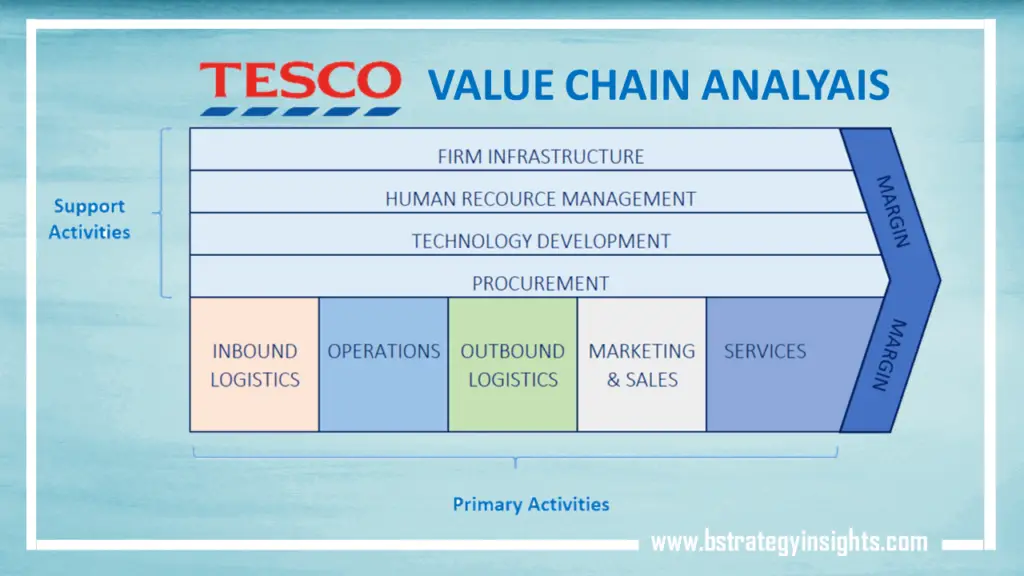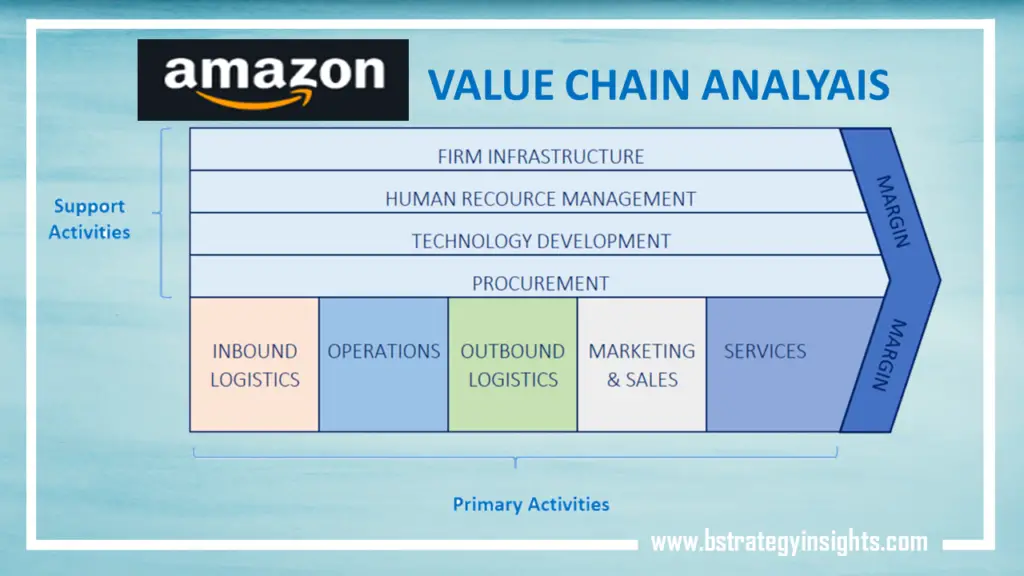
Tesco is among the top food retailers across the world. They have over 4331 stores located in 14 different parts of the world. Tesco works primarily in the United States of America, Asia, and the UK, with its head office being located in Hertfordshire. Tesco has over 960 Express stores in which almost 7000 products are available. These products are also comprised of fresh foods. Tesco also provides online retailing services.
Tesco’s Value Chain Analysis
The value chain is actually the interface between primary activities and their linkage with the support or secondary activities. The value chain is also known as a strategic assessment apparatus that is utilized for differentiating the pros and cons in the processes of value-adding.
Primary Activities of Tesco’s Value Chain Analysis
The primary value chain activities of Tesco revolve around selling their products to the targeted audience.
Inbound Logistics
The smart and nimble inbound logistics function of Tesco depicts the strategy of its overall cost leadership management. According to Abeysinghe (2010), the company’s strategy to attain less cost from its suppliers is that they use their top market status and economies of scope as a tool of bargaining. The value chain analysts have also emphasized the fact that they constantly upgrade their ordering patterns, approved vendor lists, and in-store processes to increase the efficacy of the inbound logistics operations of the company.
Operations
Tesco is popular for its efficient use of the IT department. This helps them in low-cost leadership planning. Numerous critics of the supply chain management department praise Tesco in this regard.
Tesco says that it has spent an amount of over £76 million to streamline its operations. This was done through a program called Tesco Digital program. This program has proved to be a third-generation solution of ERP for Tesco.
Tesco has gained a massive profit of over £550 million during the year 2009 only by introducing this system. One of the significant advantages of this company-wide ERP system is that it helps greatly in minimizing the stock holdings in the premises of the company.
Outbound Logistics
Tesco has a good status of leadership in both online and offline segments of food retail. This was possible because of its impressive outbound logistics. Another intelligent strategy pursued by the company was developing a smart domain of store patterns and types, which are placed on attaining increased attraction of the customers. These patterns consist of Express, Metro, Superstores, Extra, and Home plus, divided according to the requirements of the targeted audience.
Marketing and Sales
Tesco is presenting loyalty programs such as Tesco Club cards to its customers through the IT department. These services prevent Tesco customers from leaving them and going to their key competitors. Tesco has also presented a Greener Living Scheme. This scheme promises to give its customers advice on the problems of the environment. It also provides the consumers’ information about how to prevent food wastage during meal preparation.
Services
Tesco has been following a special kind of duplex scheme of cost leadership and differentiation. This has increased the importance of customer service. This dual strategy of Tesco is depicted through self-service kiosks development, finance services, focused direct marketing, and promotions.
To put the value chain analysis of Tesco in perspective, it is crucial to take into account that Tesco has been successful in generating a high degree of value as compared to its top competitors.
Secondary Activities of Tesco’s Value Chain Analysis
Tesco can be rewarded by secondary activities like they play the critical role in synchronizing and assisting the primary chain values.
Procurement
Value chain imperative for the production of a finished product involves acquiring raw materials ranging from machinery to material. Tesco must carefully analyze its procurement activities to yield a high profile inbound, operational and outbound value chain. It is inevitable because of its association with several other value chains.
The implementation of the portal value chain model relies on the clear comprehension of the significance of all the activities. Tesco must foreground where value can be put in, minimized expense, and processes can be enhanced.
Human resource management
Tesco Plc can review human resource management by evaluating several HR prospects, like performance management, rewarding, coaching, recruiting, selecting. The powerful management of HR can permit Tesco Plc to less competing pressure dependent on the abilities of its working team, commitment, and motivation. Furthermore, the team can achieve its expense minimization goals by analyzing recruiting and preparing expenses with their corresponding gain. The massive trust of Tesco in workers’ expertise will enhance the significance of this value chain support activity.
Technology Development
In a modernized, innovative, progressive period, rationally, all value chain activities are dependent on the support of technology. The technological alliance underway, making, and human resource activities require Tesco Plc to recognize the importance of the development of technology. It very well may be partitioned into process technology development activities and products. A few samples are data analytics, technology-supported customer service, product design research, and automation software.
Firm’s Infrastructure
It indicates various activities, for example, strategic control, planning, financing, accounting, legal matters, quality management. Tesco Plc streamlines the worth of the value chain by powerful infrastructure management. Tesco Plc can handle the infrastructure activities to support the dangerous situation on the business.
Cost-benefit through Tesco Value Chain Analysis
Tesco can utilize the cost benefits by decreasing the costs that have a link with the primary and secondary value chain activities.
It is required by the company that it first plans out the primary and secondary activities and then associates costs to make valuable amendments.
The link between the value chain and the strategy of cost leadership shows a distinct focus on low-cost operational activities. To accomplish the aim of obtaining cost advantage, the company needs to pinpoint each segment of the value chain and optimize it accordingly.
A Value Chain Analysis Example for Tesco is that the analysis can be used as a tool to find out the excellent prices and increase the inbound and outbound processes of transportation.
Another example of Value Chain Analysis is utilizing the value chain data to create an intelligent advertising budget that can decrease the costs of marketing. In addition to this, a plan is required to sell products at a reasonable market price.
Conclusion
As discussed in the above value chain analysis, it can be deduced that Tesco will be successful in maintaining its leadership status within the highly unpredictable retail sector, where the companies must follow the cost leadership strategies as well as the strategies of differentiation. Tesco has been successful in getting both with the support of precise and intelligent management of the supply chain. The strategic use of IT also played a vital role in its success. Tesco made sure to align the core competencies of the company with the environment of business. This highlighted a productive future scenario for the company.


